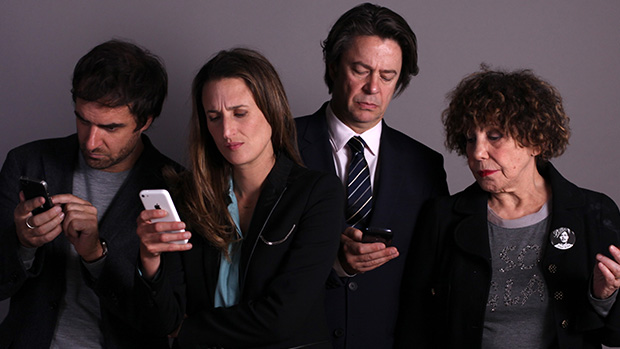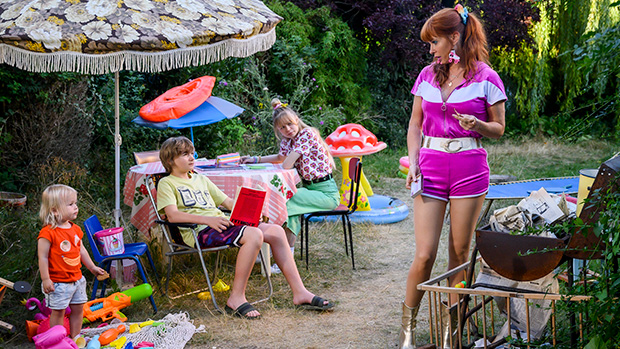De-risking scripted: Creating opportunity from crisis
By Clive Whittingham
22-04-2024
Cash-strapped and cautious broadcasters may be able to de-risk their scripted commissions and bring down their development and writing costs by turning to the formats market, according to Leona Connell, chief commercial officer at France’s Newen Connect.

Leona Connell
No area of the business is immune to the current financial crunch – unless you’re selling Premier League football rights, it seems – but original drama looks a tough pitch. Long production times and large budgets are not what any commissioning editor wants to hear at the moment, outside of the biggest global streamers.
Coproduction and alliances between broadcasters in multiple territories, particularly in Europe, have grown in prominence, but could scripted formats also be set for a surge? A proven track record elsewhere helps to de-risk the project, and a whole bible and multiple seasons worth of scripts can dramatically (sorry) cut down on the time and cost of development and writing.
It’s an opportunity out of a crisis that Leona Connell, chief commercial officer at France’s Newen Connect, has been keen to take advantage of.
The distribution arm of France-based, European-wide production group Newen, owned by commercial broadcaster TF1, has had two of the more notable scripted format successes in recent years. Multiple remakes of its Call My Agent series include Sky in Italy and Netflix in India, while more recently US broadcaster ABC has moved ahead with its version of comedy procedural HIP.
“In the market we’re in at the moment, which is so driven by that need for tried and tested content, IP, existing brands, where both streamers and brands are taking minimal risk, it makes sense to really push that side of the business,” Connell says. “We’ve had decades of unscripted formats travelling the world with huge success. In the last two years there has been a real increase and comeback of vintage formats such as Gladiators, Wheel of Fortune and our own Through The Keyhole. We decided, on the back of the success, to take some of our big French scripted shows – HPI and Call My Agent – to develop that side of the business.

Call My Agent has seen multiple remakes
“The market isn’t at its easiest at the moment. Budgets are far from bountiful in terms of acquisitions. Scripted formats present an upside of not only a good proven track record in the home territory but also it’s a quicker, cheaper way to get a programme into production. Some of the shows we sell we’ve got a lot of seasons with many episodes, being able to offer a prodco the ability to get a commission for a local adaptation of a series where they’ve got access to between 40 and 100 hours of scripts and the knowhow of a production team that has produced over many seasons is quite interesting.
“In today’s market our clients aren’t quite sure where they stand or where their budget situation is. If they do have budgets to produce locally they need to act fast and being able to buy a scripted format to fill the void of north American content which hasn’t flowed quite as plentifully since the strikes, or simply to fill gap in content because a streamer or broadcaster hasn’t been able to invest much over the last few months, it’s quite inventive.”
It’s perhaps no surprise that such successful shows in this area are emanating from France, which was more proactive, earlier, than many territories in regulating streamers and enforcing local content quotas in return for access to the market.
“In France we’re very lucky the market is dynamic,” Connell says. “Private broadcasters like TF1 have been very proactive in commissioning content, listening to the market trends and trying new dramas. We’ve had a plentiful pipeline of new dramas from TF1 including a lot of lighter procedurals which have hit a nerve internationally. The likes of France TV are also commissioning vast amounts of shows. With the whole quota situation platforms are having to invest in a lot of local content as well so we’re quite a dynamic market still despite economic challenges. Ad revenues have been less affected than other western European markets.”

French-Belgian crime-comedy television series HIP
To this end, Newen recently hired Karen Wise as senior VP of distribution for North America and UK, reporting to Connell and tasked with further building its presence in the English-speaking market by identifying coproduction and sales opportunities – particularly in scripted. Wise will work with Newen Connect’s Andrew Sime, who will continue to drive unscripted formats. Wise previously had stints with Rainmaker Content, Sky Vision and Target Entertainment.
“We’re looking to develop those two territories but also our scripted formats business globally,” Connell says. “Karen’s got great experience from Sky and smaller indie producer and distributors, it gives a good understanding of global market in terms of scripted formats and local production companies. It’s going to be part of that remit to work with the sales team to identify key territories which our formats are best suited to in those territories.”
As far as key ingredients to help a drama travel as a format, Connell cites, as well as proven IP and track record, universal themes that can be adapted with local actors and stories to anchor the project in its new home territory.
Three specific trends she sees Newen potentially being able to tap into in this area are: daily, daytime shows and soaps; English-language drama; and kids or young adult scripted content.
In soaps, Mega in Greece recently commissioned a local 100-episode adaptation of French daytime drama Tomorrow Is Ours/Demain Nous Appartient which Newen originally produced for TF1. Deals are now being eyed for another TF1 series Where It All Begins/Ici Tout Commence which is set in a high-end culinary school for potential Michelin-starred chefs.
“Priority wise for us we’re really looking to bring in more English language drama,” says Connell, citing a recent deal with Jude Law’s Riff Raff to take a first look at their projects.
In young adult content The First Years, originally produced by Newen-owned Tuvalu for NPO in the Netherlands, has already had remakes in Sweden, Denmark, Poland, the UK and Canada, but could also be ripe for a reboot.
“There’s a big focus on IP we’ve already got in the catalogue and as well as drama and daily shows we’ve also got kids series,” Connell says. “First Years has got social messages and themes young people are interested in. It’s another genre, kids’ drama, but again an example of how scripted formats can be a success and we want to reinvigorate.”
READ LESSCash-strapped and cautious broadcasters may be able to de-risk their scripted commissions and bring down their development and writing costs by turning to the formats market, according to Leona Connell, chief commercial officer at France’s Newen Connect.

Leona Connell
No area of the business is immune to the current financial crunch – unless you’re selling Premier League football rights, it seems – but original drama looks a tough pitch. Long production times and large budgets are not what any commissioning editor wants to hear at the moment, outside of the biggest global streamers.
Coproduction and alliances between broadcasters in multiple territories, particularly in Europe, have grown in prominence, but could scripted formats also be set for a surge? A proven track record elsewhere helps to de-risk the project, and a whole bible and multiple seasons worth of scripts can dramatically (sorry) cut down on the time and cost of development and writing.
It’s an opportunity out of a crisis that Leona Connell, chief commercial officer at France’s Newen Connect, has been keen to take advantage of.
The distribution arm of France-based, European-wide production group Newen, owned by commercial broadcaster TF1, has had two of the more notable scripted format successes in recent years. Multiple remakes of its Call My Agent series include Sky in Italy and Netflix in India, while more recently US broadcaster ABC has moved ahead with its version of comedy procedural HIP.
“In the market we’re in at the moment, which is so driven by that need for tried and tested content, IP, existing brands, where both streamers and brands are taking minimal risk, it makes sense to really push that side of the business,” Connell says. “We’ve had decades of unscripted formats travelling the world with huge success. In the last two years there has been a real increase and comeback of vintage formats such as Gladiators, Wheel of Fortune and our own Through The Keyhole. We decided, on the back of the success, to take some of our big French scripted shows – HPI and Call My Agent – to develop that side of the business.

Call My Agent has seen multiple remakes
“The market isn’t at its easiest at the moment. Budgets are far from bountiful in terms of acquisitions. Scripted formats present an upside of not only a good proven track record in the home territory but also it’s a quicker, cheaper way to get a programme into production. Some of the shows we sell we’ve got a lot of seasons with many episodes, being able to offer a prodco the ability to get a commission for a local adaptation of a series where they’ve got access to between 40 and 100 hours of scripts and the knowhow of a production team that has produced over many seasons is quite interesting.
“In today’s market our clients aren’t quite sure where they stand or where their budget situation is. If they do have budgets to produce locally they need to act fast and being able to buy a scripted format to fill the void of north American content which hasn’t flowed quite as plentifully since the strikes, or simply to fill gap in content because a streamer or broadcaster hasn’t been able to invest much over the last few months, it’s quite inventive.”
It’s perhaps no surprise that such successful shows in this area are emanating from France, which was more proactive, earlier, than many territories in regulating streamers and enforcing local content quotas in return for access to the market.
“In France we’re very lucky the market is dynamic,” Connell says. “Private broadcasters like TF1 have been very proactive in commissioning content, listening to the market trends and trying new dramas. We’ve had a plentiful pipeline of new dramas from TF1 including a lot of lighter procedurals which have hit a nerve internationally. The likes of France TV are also commissioning vast amounts of shows. With the whole quota situation platforms are having to invest in a lot of local content as well so we’re quite a dynamic market still despite economic challenges. Ad revenues have been less affected than other western European markets.”

French-Belgian crime-comedy television series HIP
To this end, Newen recently hired Karen Wise as senior VP of distribution for North America and UK, reporting to Connell and tasked with further building its presence in the English-speaking market by identifying coproduction and sales opportunities – particularly in scripted. Wise will work with Newen Connect’s Andrew Sime, who will continue to drive unscripted formats. Wise previously had stints with Rainmaker Content, Sky Vision and Target Entertainment.
“We’re looking to develop those two territories but also our scripted formats business globally,” Connell says. “Karen’s got great experience from Sky and smaller indie producer and distributors, it gives a good understanding of global market in terms of scripted formats and local production companies. It’s going to be part of that remit to work with the sales team to identify key territories which our formats are best suited to in those territories.”
As far as key ingredients to help a drama travel as a format, Connell cites, as well as proven IP and track record, universal themes that can be adapted with local actors and stories to anchor the project in its new home territory.
Three specific trends she sees Newen potentially being able to tap into in this area are: daily, daytime shows and soaps; English-language drama; and kids or young adult scripted content.
In soaps, Mega in Greece recently commissioned a local 100-episode adaptation of French daytime drama Tomorrow Is Ours/Demain Nous Appartient which Newen originally produced for TF1. Deals are now being eyed for another TF1 series Where It All Begins/Ici Tout Commence which is set in a high-end culinary school for potential Michelin-starred chefs.
“Priority wise for us we’re really looking to bring in more English language drama,” says Connell, citing a recent deal with Jude Law’s Riff Raff to take a first look at their projects.
In young adult content The First Years, originally produced by Newen-owned Tuvalu for NPO in the Netherlands, has already had remakes in Sweden, Denmark, Poland, the UK and Canada, but could also be ripe for a reboot.
“There’s a big focus on IP we’ve already got in the catalogue and as well as drama and daily shows we’ve also got kids series,” Connell says. “First Years has got social messages and themes young people are interested in. It’s another genre, kids’ drama, but again an example of how scripted formats can be a success and we want to reinvigorate.”














.jpg)




























